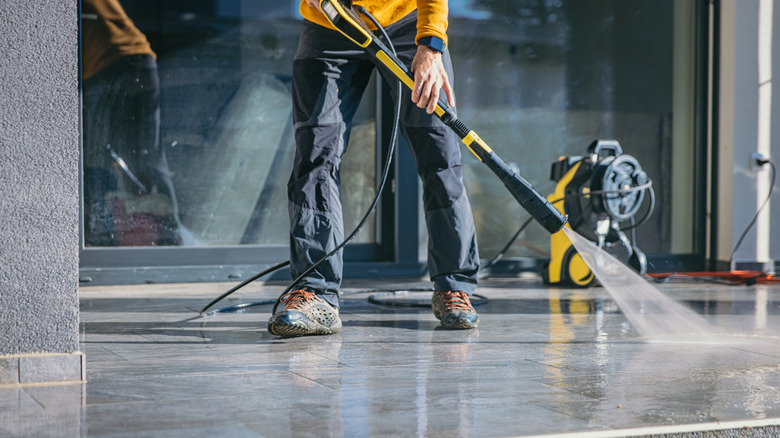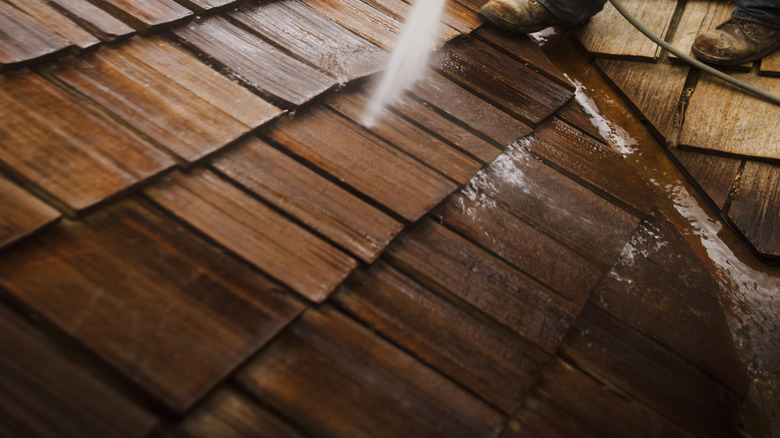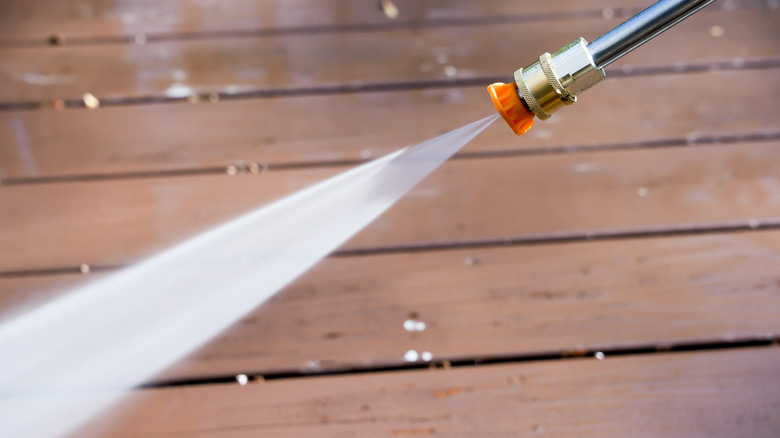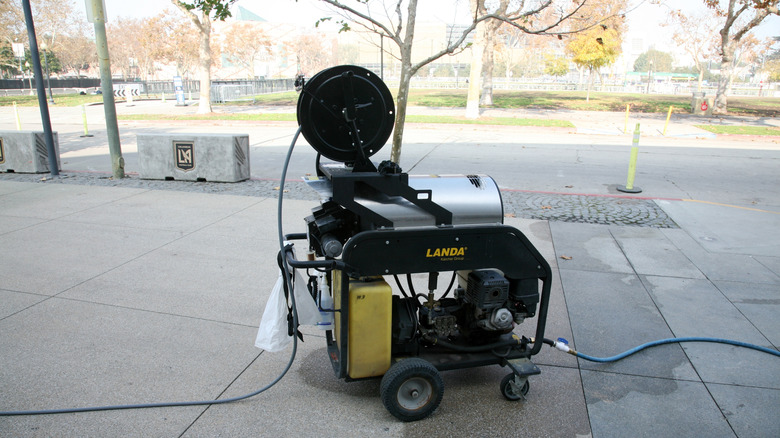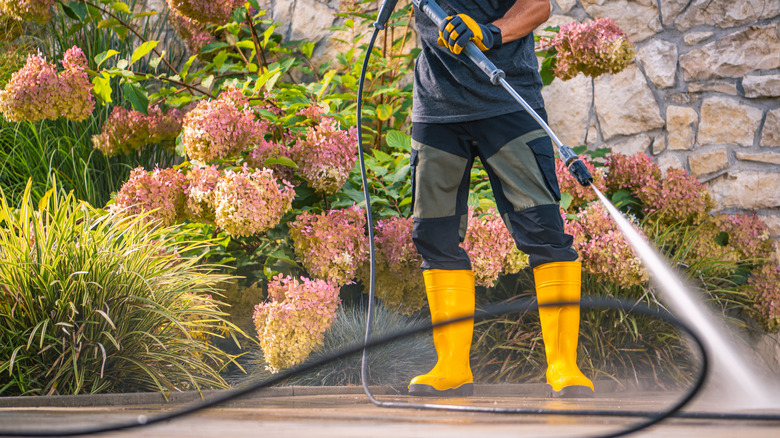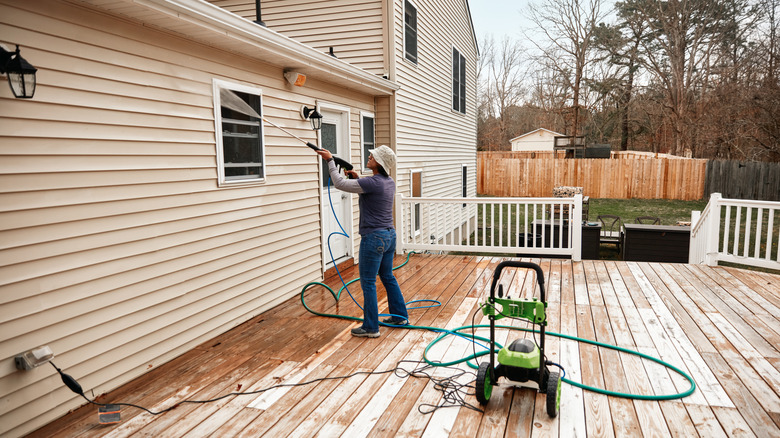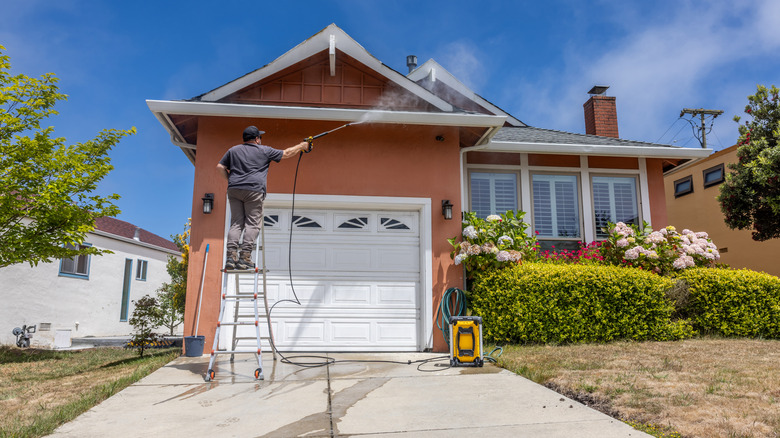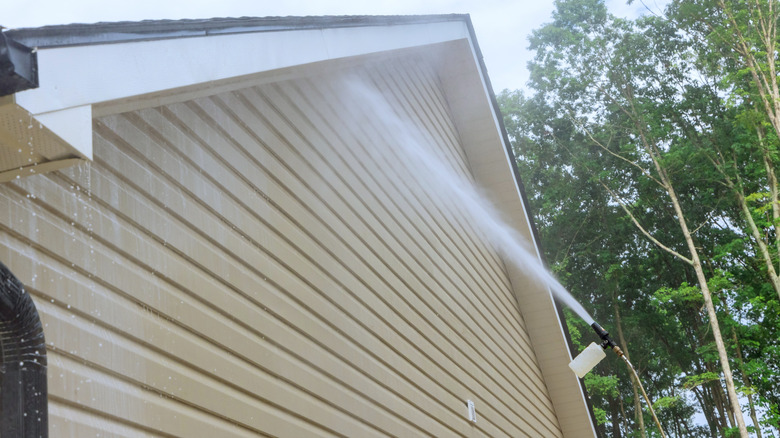Mistakes Everyone Makes When Pressure Washing
Thinking about using your pressure washer to clean items around your house? It's a convenient tool that can effectively remove dirt, algae, and debris from outside surfaces, improving curb appeal and preventing damage from the buildup. When paired with the right detergent, your pressure washer tackles tough cleaning projects quickly with less effort on your part. Pressure washers let you adjust the pressure of the water and use different nozzles for targeted cleaning of decks, fences, driveways, and other sturdy outdoor surfaces.
A pressure washer seems easy enough to use, but going into the project without knowledge on the tool could be a mistake. Many common pressure washer mistakes (such as using it on the wrong surfaces, choosing the wrong nozzle, using the incorrect pressure setting, and working at a bad angle), could damage the surface that you're washing. Other common issues include using only water, skipping safety practices, and cleaning in the wrong order. Making those mistakes may give you poor cleaning results that require even more time to fix.
Pressure-washing the wrong surfaces
There are several things you should never clean with a pressure washer because of the potential for damage. Keep the pressure washer away from electric meters, generators, air conditioners, solar panels, light fixtures, and other electrical components or appliances. Many of these electrical items have delicate components, including wiring, hoses, and panels that you can destroy with pressurized water. If water gets inside the electrical components, it could cause power issues, including short circuits, corrosion, or shocks.
Never pressure wash windows or other glass surfaces as the pressure could crack or shatter the fragile material. Exterior awnings and shades could tear under the pressure. Other items might not break completely, but they can suffer damage if you pressure wash them. Gutters could become disconnected from the roof, for example. Pressure-washing shingles may loosen them or remove the granules on asphalt shingles. You could also force water under the shingles, where it can leak into your attic. Wood structures, including fences and siding, can become gouged or splintered with high-pressure water. Even vinyl can become punctured or dented under high pressure.
Beyond the potential for damage, pressure washing certain items around your home could void the warranty. This may include warranties on siding, composite decking, fencing, and shingles. Before you pressure wash any surfaces that still have warranties on them, read the terms of the warranty to look for exclusions for damage caused by pressure washing.
Using the wrong nozzles
When you pull out your pressure washer, you may notice almost a rainbow of nozzle options. Don't make the mistake of thinking they're all the same. The colors indicate the degree of the spray, which determines how wide of a V shape the water makes. Wider sprays associated with larger degrees offer gentler cleaning than narrower spray patterns. Using the wrong nozzle affects your results. A nozzle that's too powerful for the material may damage the surface, whereas a weaker nozzle may not offer enough cleaning power to handle tough jobs.
Red nozzles feature a 0-degree spray pattern, creating a concentrated stream of water. It might be tempting to use this powerful nozzle on all tough jobs, but it's not safe for wood, painted surfaces, and any delicate materials. It is, however, ideal for metal and concrete. The 15-degree spray pattern of the yellow nozzle makes it a powerful option for deep cleaning on unpainted, sturdy surfaces, such as concrete and brick walkways. You can also use it to strip decks or siding if you're going to refinish those areas. Green nozzles use a 25-degree spray to offer standard cleaning for most surfaces unless they're too delicate for spray washing in general. With a 40-degree angle, white nozzles are suitable for softer woods and painted surfaces when used carefully. The black nozzle is a special low-pressure option sometimes called a detergent nozzle. Its 65-degree angle offers light pressure and is ideal when using cleaners.
Choosing a setting that's too high for the job
Ignoring the maximum psi when you buy a pressure washer could result in buying a tool that doesn't meet your needs. Light-duty models for home use typically go up to 1,899 psi. Heavy-duty models offer about 2,800 psi, and medium-duty models fall in between the two. Models with 3,100 psi and higher are commercial-grade pressure washers. If you buy a light-duty pressure washer, it won't have the cleaning power to handle heavy-duty jobs like stripping paint. Buying a higher-powered model when you only plan to do light cleaning could be a waste of money. The fuel source also impacts the power — one of the little-known downsides to electric pressure washers is that they aren't equipped to handle larger jobs. Gas models usually come with higher psi settings and can tackle heavier-duty cleaning better.
You can also make a mistake with psi when you use your pressure washer. Adjusting the psi setting for the specific job or material you're washing prevents damage from overly harsh pressure. For many residential cleaning projects, an ideal setting is 1,300 to 1,800 psi. If you plan to clean concrete or other hard surfaces, using 2,000 to 3,000 psi helps you tackle the work. You typically only need 3,000 psi or higher for industrial-type applications, such as removing graffiti or stripping paint. Starting with a lower psi setting could help protect the surfaces you're cleaning. Give the machine a chance to clean at the lower setting. Increase the pressure gradually when needed to find a setting that removes the dirt safely.
Skipping detergents and cleaners
You can use your pressure washer without detergents or cleaners, but you're missing out on extra cleaning power when you combine the water force with targeted cleaning products. Some messes you're cleaning need the active ingredients in specific cleaning products. Degreasers help clean up greasy, oily stains like the ones you might find on your driveway. Pressure washer detergent for wood decks and fences often brightens the wood and helps remove algae, mold, and mildew that may grow on the surfaces.
The special formulations use chemicals that are safe and effective for particular materials. For example, degreasers may be too harsh for some materials, such as wood or siding. Deck-specific products are made with ingredients that are safe for wood and composite materials. You can also find biodegradable cleaning solutions that are environmentally friendly and keep nearby plants safe.
Using the wrong type of soap is also a big mistake. Household cleaners like dish soap could damage your pressure washer. Only use cleaners that are formulated for the machine. Check your owner's manual to look for specific recommendations or chemicals you should avoid. Some cleaning products could even void your pressure washer warranty. If you use a concentrate, follow the instructions to dilute the cleaner properly.
Working in the wrong order
Failing to think about where you start with your pressure washing could be a mistake that creates more work. When you're cleaning your home's exterior, you might pressure wash more than one surface, such as your siding, deck, sidewalks and driveway. Working in the wrong order could cause dirty water and soap to flow over areas you've already cleaned.
To make sure you're pressure washing the house in the right order, start at the highest point and work downward. This rule applies even if you're only cleaning one structure, such as a fence. Working from the top of the fence down toward the ground allows the dirty water to flow over the remaining dirty portions. If you start at the bottom, the cleaning solution from the top could make the bottom section dirty again. When deciding where to start, think about how the water will flow from different areas. If you're washing a relatively flat surface like a driveway, look for the slope that's usually there and start at the higher point.
Ignoring safety protocols
A big mistake you can make is assuming a pressure washer is like a garden hose and doesn't require any special protection. The intense pressure from the machine can severely damage exposed skin. It can also push objects into other people or structures, potentially causing injuries. Shocks can also happen if you use the pressure washer improperly. Reading the manual is one of the first precautions to take when pressure washing. It helps you understand how to use the machine correctly and learn about specific safety features, which might include a safety latch on the handle to keep the machine from spraying accidentally.
Gear up before pressure washing by covering up as much of your skin as possible. Always wear closed-toed shoes made of sturdy materials. Rubber-soled shoes may provide some protection from shocks. Since your hands are often close to the spray and susceptible to injury, wearing rubber gloves while you clean adds a layer of protection. Eye protection or a face shield is also helpful in case water or debris splashes onto your face.
If you're using a gas pressure washer, only use it outdoors in open areas away from windows, doors, and vents on your home — at least 20 feet away from those openings. This reduces the risk of carbon monoxide buildup inside your home. For electric pressure washers, use a properly grounded outlet. When necessary, use a heavy-duty, wet-rated extension cord, ensuring the connection point is in a dry area free of standing water. Skip standing on ladders while using the pressure washer as the force could make you lose your balance.
Using a bad angle or the wrong distance
The way you hold the nozzle in comparison to the surface you're cleaning can also be a mistake. Going straight at the surface often pushes the dirt deeper into porous materials. It can also send the dirty water straight back toward your body, including your face. Instead, direct the water toward the surface at an angle to help ease dirt off of the surface and push it away to the side. You may need to try different angles, especially on tough stains.
Another mistake related to how you position the sprayer is the distance between the nozzle and the surface you're cleaning. Holding it too close to the object could gouge or dent the material. Leave about 4 feet of distance to start. If you need to move closer to the surface to clean it effectively, do so slowly, only getting as close as necessary.
The direction in which you spray the water is more important on certain surfaces, such as siding. If you spray into the bottom edges of the siding panels, the water may end up behind the siding, where it can cause water damage and mold growth. The powerful stream could also loosen your siding when you go in from the bottom. Angling the spray downward when you clean your exterior siding helps remove grime from your siding with less risk for damage.
